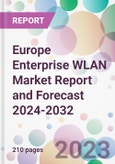Enterprise WLAN solutions are designed to allow seamless and secure internet connectivity in various enterprise environments, from small startups to large corporations. These networks are critical in supporting mobile devices, enabling a range of applications that improve productivity, collaboration, and employee satisfaction in the workplace.
In Europe, the increasingly mobile nature of the workforce is a significant Europe enterprise WLAN market trend. As work becomes more flexible and remote working practices continue, companies are investing in robust WLAN solutions to enable secure and efficient work from anywhere. Additionally, the integration of IoT devices into the corporate environment is creating a need for secure and reliable wireless connectivity, driving the Europe enterprise WLAN market growth.
Advancements in cloud-managed WLAN solutions are making the deployment and operation of enterprise wireless networks more efficient. Such innovations enable European enterprises to outsource WLAN operations to third-party specialists or manage large-scale deployments centrally. Additionally, security enhancements are continuously being developed to protect enterprise networks from the growing cybersecurity threats, further driving the Europe enterprise WLAN market demand.
The European enterprise WLAN market is segmented based on components into hardware, software, and services. While hardware components currently hold a significant share of the market, managed services are projected to grow at an impressive rate due to enterprises’ growing preference for outsourced network management solutions.
The European enterprise WLAN market is highly competitive, with key players including Cisco Systems, Aruba Networks (a Hewlett Packard Enterprise company), and Ruckus Wireless. These companies are engaging in strategies such as product innovation, partnerships, and acquisitions to maintain and enhance their Europe enterprise WLAN market outlook.
As technologies such as Wi-Fi 6 and 5G continue to develop, European enterprises are likely to invest further in their WLAN solutions to harness these new capabilities. The trend towards more intelligent, self-optimising networks is also likely to continue, with AI and machine learning technologies playing a significant role in the evolution of enterprise WLAN solutions.
Market Segmentation
The market can be divided based on component, organisation size, end use, and country.Market Breakup by Component
- Hardware
- Software
- Services
Market Breakup by Enterprise Organisation Size
- Large Enterprises
- Small and Medium Enterprises
Market Breakup by End Use
- Banking, Financial Services and Insurance
- Healthcare
- Retail
- IT and Telecommunications
- Others
Market Breakup by Country
- United Kingdom
- Germany
- France
- Italy
- Others
Competitive Landscape
The report looks into the market shares, plant turnarounds, capacities, investments, and mergers and acquisitions, among other major developments, of the leading companies operating in the Europe enterprise WLAN market. Some of the major players explored in the report are as follows:- Cisco Systems Inc.
- Hewlett Packard Enterprise Development LP
- Arista Networks, Inc.
- Ubiquiti Inc.
- CommScope, Inc.
- Huawei Technologies Co., Ltd.
- Dell Inc.
- Juniper Networks, Inc.
- Others
Table of Contents
Companies Mentioned
- Cisco Systems Inc.
- Hewlett Packard Enterprise Development LP
- Arista Networks Inc.
- Ubiquiti Inc.
- CommScope Inc.
- Huawei Technologies Co. Ltd.
- Dell Inc.
- Juniper Networks Inc.
Methodology

LOADING...








